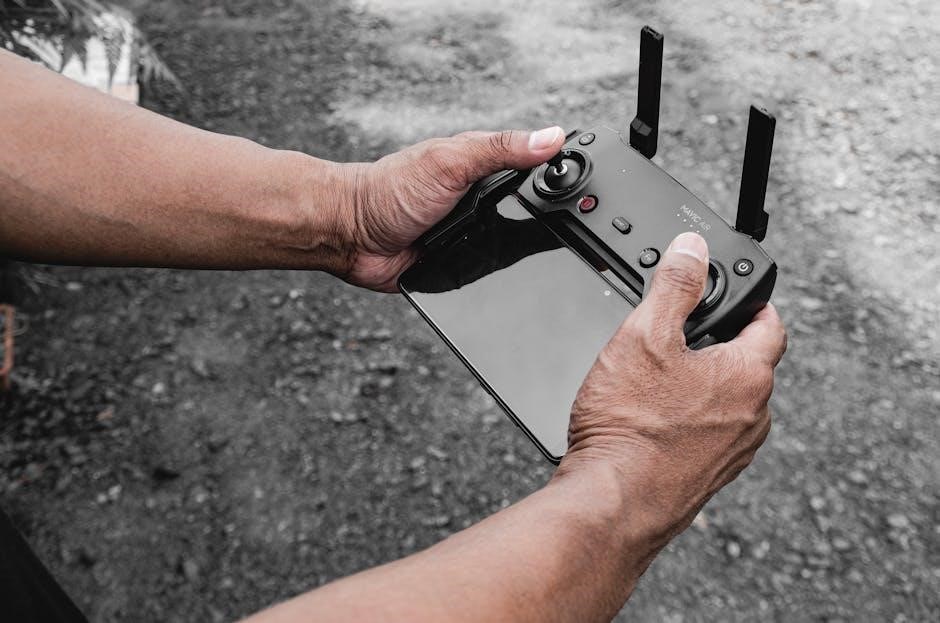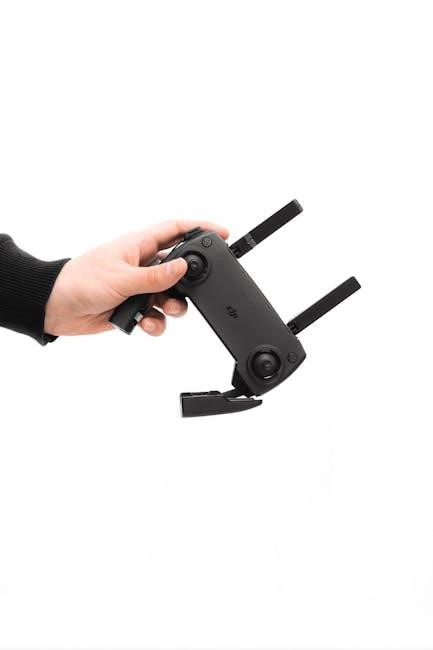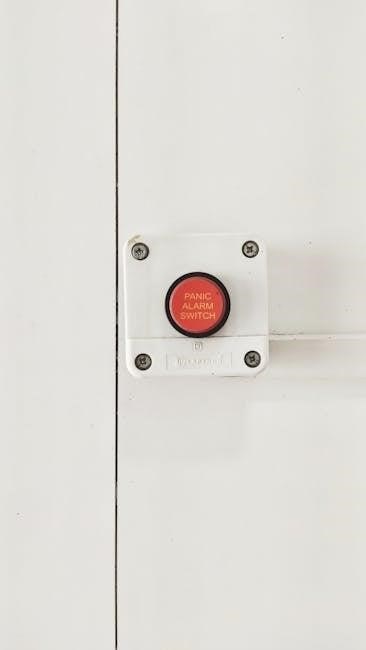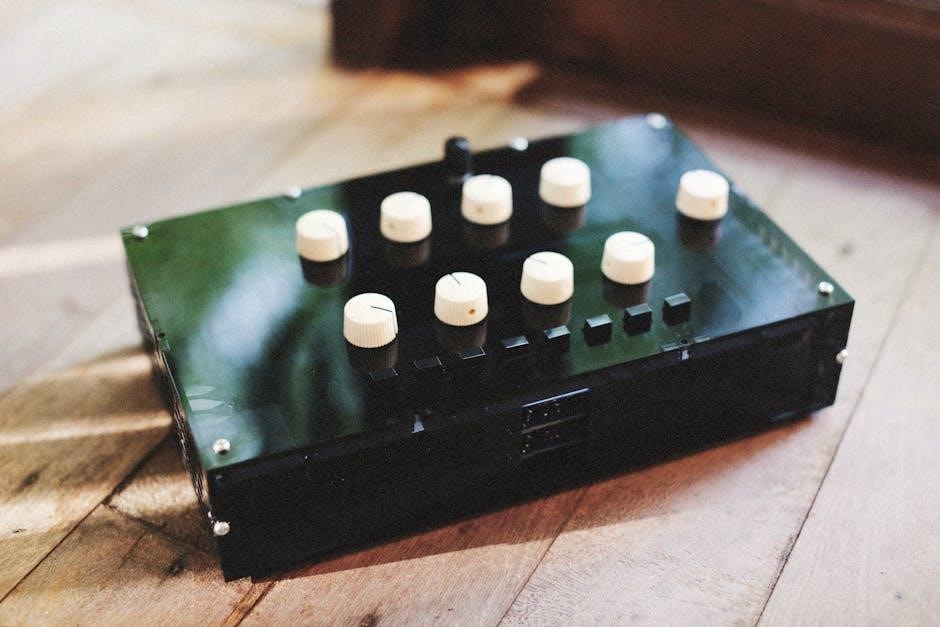ke2 controller manual pdf

Welcome to the KE2 Controller Manual‚ your comprehensive guide to understanding and operating the KE2 temperature and defrost controller. This manual provides detailed instructions for installation‚ configuration‚ and troubleshooting‚ ensuring optimal performance in refrigeration systems.
Overview of the KE2 Controller
The KE2 Controller is a sophisticated electronic device designed for efficient temperature management in refrigeration systems. It offers advanced features like energy-saving defrost control‚ automated monitoring‚ and compatibility with various refrigeration setups. The controller is engineered to optimize performance‚ reduce energy consumption‚ and ensure reliable operation in walk-in coolers‚ freezers‚ and warehouses. Its user-friendly interface and customizable settings enable precise control over defrost cycles‚ temperature setpoints‚ and system monitoring. With robust construction and intuitive design‚ the KE2 Controller is a versatile solution for maintaining optimal conditions in commercial refrigeration environments. This manual provides detailed guidance for installation‚ configuration‚ and troubleshooting‚ ensuring seamless integration and operation.
Importance of the KE2 Controller Manual
The KE2 Controller Manual is an essential resource for users‚ providing comprehensive guidance on installation‚ operation‚ and maintenance. It ensures proper setup and configuration‚ maximizing the controller’s efficiency and longevity. The manual offers troubleshooting tips and detailed explanations of features‚ helping users resolve issues quickly. By following the manual’s instructions‚ users can optimize energy savings‚ maintain precise temperature control‚ and extend the lifespan of their refrigeration system. This document is crucial for both new and experienced users‚ serving as a reference for achieving optimal performance and compliance with technical specifications. It is recommended to keep the manual on site for easy access during operation and maintenance.

Key Features of the KE2 Controller
The KE2 Controller offers advanced defrost control‚ energy-saving modes‚ and compatibility with various refrigeration systems. It provides precise temperature management and automated monitoring for optimal performance.
Energy-Saving Defrost Control
The KE2 Controller features an advanced energy-saving defrost control system designed to optimize refrigeration efficiency. By monitoring system performance‚ it determines the optimal defrost timing‚ reducing unnecessary cycles and minimizing energy consumption. This adaptive technology ensures that defrost operations occur only when needed‚ preventing excessive ice buildup while maintaining consistent temperatures. The controller’s defrost algorithm adjusts based on real-time data‚ such as evaporator coil conditions and system demand‚ to maximize energy savings without compromising performance. This intelligent approach not only lowers operational costs but also extends the lifespan of system components by reducing wear and tear from frequent defrosting.
Advanced Monitoring and Automation
The KE2 Controller offers advanced monitoring and automation capabilities‚ enabling precise control over refrigeration systems. Real-time data on temperature‚ defrost cycles‚ and system performance is displayed‚ allowing for informed decision-making. Automated defrost initiation and temperature adjustments ensure optimal efficiency and reduced manual intervention. The controller’s intuitive interface simplifies navigation‚ with customizable settings to meet specific operational needs. Remote monitoring options provide flexibility‚ allowing users to manage the system from a central location. Automated alerts and notifications ensure prompt issue resolution‚ minimizing downtime. This advanced monitoring and automation ensure seamless operation‚ energy efficiency‚ and extended system longevity‚ making the KE2 Controller a reliable choice for modern refrigeration management.
Compatibility with Various Refrigeration Systems
The KE2 Controller is designed for seamless integration with a wide range of refrigeration systems‚ ensuring versatility and adaptability. It supports both new and existing setups‚ including walk-in coolers‚ freezers‚ and refrigerated warehouses. The controller’s universal compatibility allows it to work with diverse components‚ such as evaporators‚ compressors‚ and defrost heaters‚ making it a flexible solution for various applications. Its adjustable parameters and multiple input/output options facilitate easy adaptation to different system requirements. This broad compatibility ensures that the KE2 Controller can be efficiently utilized across various industries‚ from food storage to pharmaceutical applications‚ providing reliable performance and energy efficiency in every setup. Its universal design minimizes installation challenges and maximizes operational efficiency‚ making it a preferred choice for refrigeration system control.

Installation and Setup
The KE2 Controller installation involves mounting the unit‚ connecting sensors‚ and configuring initial settings. Follow the wiring diagram and instructions carefully for a smooth setup process.
Hardware Mounting and Wiring
Connecting Sensors and Accessories
To ensure proper functionality‚ carefully connect all sensors and accessories to the KE2 Controller. Begin by attaching the temperature probes to the designated terminals‚ ensuring they are securely fastened. Next‚ connect the defrost sensors according to the wiring diagram provided in the manual. For remote monitoring‚ use the RJ-45 cable to link the KE2 WiFi Service Tool to the controller. Verify that all connections are tight and correctly paired to avoid malfunctions. Finally‚ power up the controller and test each sensor and accessory to confirm they are functioning as intended. Proper connections are critical for accurate temperature control and defrost operations. Always follow the manual’s guidelines for safe and reliable setup.
Initial Configuration and Calibration

After installation‚ initialize the KE2 Controller by setting the time and date in the format. Navigate to the control panel and access the initial setup menu. Configure basic settings such as temperature units (°F or °C) and defrost modes (manual or automatic). Enter the defrost interval and duration based on your system requirements. Refer to the manual for specific parameter guidelines. Calibrate sensors by ensuring they are properly connected and configured. Save all settings and restart the controller to apply changes. For precise operation‚ follow the manual’s calibration procedures to optimize performance. Proper configuration ensures reliable temperature control and efficient defrost cycles. Always refer to the manual for detailed calibration instructions. This step is crucial for achieving optimal system performance.

Operating the KE2 Controller
Learn to navigate the control panel‚ monitor temperature settings‚ and manage defrost cycles efficiently. Understand display indicators and alarms for smooth operation. Refer to the manual for detailed guidance.
Navigating the Control Panel
The KE2 controller features an intuitive control panel designed for easy operation. The display provides clear status updates‚ while buttons allow users to adjust settings and access menus. Use the navigation keys to scroll through options and select functions. The manual defrost mode can be activated directly from the panel‚ ensuring precise control over refrigeration cycles. Familiarize yourself with the layout to optimize efficiency and maintain system performance. Refer to the manual for detailed instructions on utilizing advanced features and customizing settings to meet specific requirements.
Understanding Display Indicators and Alarms
The KE2 controller’s display provides essential information about system status‚ defrost modes‚ and error conditions. Visual indicators show active defrost cycles‚ sensor readings‚ and alarm states. Audible alarms alert users to potential issues‚ such as sensor malfunctions or communication errors. Familiarize yourself with the display symbols and alarm codes to quickly identify and address system conditions; Refer to the manual for a detailed list of indicators and their meanings. Understanding these signals ensures timely responses to system notifications‚ maintaining optimal performance and preventing operational disruptions. Regularly monitoring the display helps anticipate and resolve issues before they escalate.
Manual vs. Automated Defrost Modes
The KE2 controller offers two defrost modes: manual and automated. Manual defrost mode allows users to initiate defrost cycles on demand‚ providing control during maintenance or specific operational needs. Automated defrost mode‚ however‚ optimizes efficiency by activating defrost cycles based on system demand‚ reducing unnecessary energy usage. The controller’s advanced algorithm ensures defrost operations align with actual system requirements‚ minimizing downtime and prolonging equipment life. Switching between modes is straightforward via the control panel‚ offering flexibility for varying operational scenarios. Understanding these modes enables users to tailor defrost operations to their specific needs‚ balancing energy savings with system performance. Proper mode selection is crucial for maintaining optimal refrigeration system efficiency and reliability.

Troubleshooting Common Issues
This section guides you through identifying and resolving common issues with the KE2 controller‚ such as sensor malfunctions or communication errors‚ ensuring smooth system operation.
Diagnosing Fault Codes
The KE2 controller provides specific fault codes to help identify system issues. Start by checking the display for error messages like “E1” or “E2‚” which indicate sensor or communication problems. Refer to the manual for code definitions. Perform a self-test by navigating to the diagnostic menu. Verify wiring connections and sensor accuracy. Restart the controller to clear temporary glitches. If issues persist‚ consult the troubleshooting section or contact technical support. Regularly updating firmware can prevent recurring faults. Always document the error codes for faster resolution. This systematic approach ensures efficient problem-solving and minimizes downtime‚ keeping your refrigeration system operational. Use this guide to address faults effectively and maintain optimal performance.
Resolving Sensor Malfunctions
Sensor malfunctions in the KE2 controller can disrupt system performance. Start by checking sensor connections for looseness or damage. Ensure proper wiring and verify that sensors are calibrated correctly. Clean sensors to remove dirt or ice buildup‚ which may cause inaccurate readings. If issues persist‚ recalibrate or replace faulty sensors. Refer to the manual for specific calibration procedures. For temperature or defrost sensors‚ check for proper installation and alignment. Use diagnostic tools to identify error codes linked to sensor failure. If problems remain unresolved‚ consult the troubleshooting guide or contact technical support for assistance. Regular maintenance and inspections can prevent sensor-related issues‚ ensuring reliable operation. Follow these steps to restore accurate sensor functionality and maintain optimal system efficiency.
Addressing Communication Errors
Communication errors in the KE2 controller can disrupt system operation. Begin by checking all wiring connections‚ ensuring they are secure and free from damage. Verify that Ethernet or serial cables are properly connected to the controller and associated devices. Restart the controller to reset communication channels. Check for error codes on the display‚ which can indicate specific issues. Use diagnostic tools to identify and resolve network or software conflicts. Ensure firmware is up-to-date‚ as outdated versions may cause compatibility problems. If issues persist‚ consult the troubleshooting section of the manual or contact technical support for further assistance. Regularly inspect communication ports and cables to prevent future disruptions. Addressing these errors promptly ensures seamless system operation and data transmission. Follow these steps to restore communication functionality effectively.

Advanced Settings and Customization
Adjust defrost parameters‚ configure temperature setpoints‚ and enable remote monitoring for tailored performance. Customize settings to optimize energy efficiency and system operation based on specific requirements.
Adjusting Defrost Parameters
Adjusting defrost parameters on the KE2 controller allows for precise control over defrost cycles‚ optimizing energy efficiency and system performance. Access the defrost settings via the control panel by navigating to the “Defrost Parameters” menu. Here‚ you can modify the defrost interval‚ duration‚ and demand-based settings to suit your specific refrigeration needs. The KE2 controller features an advanced defrost algorithm that adapts to system conditions‚ reducing unnecessary defrost cycles. Ensure adjustments align with your system’s operational requirements to maintain optimal performance and minimize energy consumption. Refer to the manual for detailed steps on customizing these settings for maximum efficiency and reliability in your refrigeration application.
Configuring Temperature Setpoints

Configuring temperature setpoints on the KE2 controller ensures precise temperature regulation for optimal performance. Access the temperature settings via the control panel by selecting the “Temperature Setpoints” menu. Here‚ you can set distinct temperatures for cooling and defrost modes‚ tailored to your system’s requirements. The KE2 controller allows for fine-tuned adjustments‚ enabling you to customize temperature thresholds to maintain consistent refrigeration levels. Ensure that setpoints align with your application’s needs to prevent overheating or overcooling. Use the manual’s instructions to guide you through the process‚ ensuring accurate and efficient temperature control. Proper configuration enhances energy efficiency and system reliability‚ making it essential for achieving desired operational outcomes in refrigeration environments.
Setting Up Remote Monitoring
Setting up remote monitoring for the KE2 controller allows you to track system performance from a distance‚ enhancing convenience and efficiency. Begin by connecting the controller to your local network using an RJ-45 cable. Ensure the controller’s IP address is configured correctly within your network settings. Next‚ access the controller’s web interface by entering its IP address into a web browser. From there‚ enable remote monitoring features and set up user credentials for secure access. You can also integrate the controller with external monitoring systems or software‚ providing real-time data and alerts. This feature is particularly useful for managing multiple refrigeration systems or receiving notifications for maintenance needs‚ ensuring optimal performance and reducing downtime.

Maintenance and Technical Support
Regular maintenance ensures optimal performance. Schedule inspections‚ update software‚ and clean components. For technical support‚ contact KE2 Therm Solutions or refer to the provided documentation.

Scheduled Maintenance Procedures
Regular maintenance is essential to ensure the KE2 controller operates efficiently. Inspect wiring and connections monthly to prevent issues. Clean the controller’s exterior and internal components every 6 months. Update software periodically to access new features and improvements. Refer to the KE2 Controller Manual for detailed procedures.
Calibrate sensors annually to maintain accuracy. Replace worn or damaged parts promptly to avoid system downtime. Schedule professional checks every 2 years for advanced diagnostics. Keep the manual on site for quick reference during maintenance tasks. Proper upkeep ensures reliable performance and extends the controller’s lifespan.
Accessing Technical Documentation
The KE2 controller manual is available on the manufacturer’s official website in PDF format‚ providing detailed installation‚ operation‚ and troubleshooting guides. This document includes wiring diagrams‚ specifications‚ and maintenance tips. It serves as a vital resource for understanding the controller’s features and resolving issues promptly. Users can download the manual directly from the support section of the website. Ensure the manual is kept on site for easy reference during setup and maintenance tasks. The document is periodically updated‚ so check for the latest version to access the most current information and guidelines for optimal performance. This ensures users have the most accurate and comprehensive support material available.
Contacting Customer Support
For assistance with the KE2 controller‚ customers can reach out to the manufacturer’s support team through various channels. Visit the official website to find contact details‚ including email‚ phone numbers‚ and live chat options. Technical support is available to address installation‚ operation‚ or troubleshooting issues. When contacting support‚ ensure you have the model number and a detailed description of the issue for quicker resolution. Additionally‚ the KE2 controller manual PDF includes a section with contact information and support resources. Representatives are trained to provide effective solutions‚ ensuring minimal downtime and optimal performance of your refrigeration system. Regular updates and FAQs are also available on the website to help users resolve common issues independently.
The KE2 Controller Manual provides a thorough understanding of its features‚ ensuring energy efficiency and optimal performance. By following the guidelines‚ users can master its operation and troubleshooting‚ achieving superior refrigeration management.
This manual provides a comprehensive guide to the KE2 Controller‚ focusing on its advanced features‚ installation‚ and operation. Key highlights include energy-saving defrost control‚ automated monitoring‚ and compatibility with various refrigeration systems. The manual details step-by-step installation processes‚ sensor connections‚ and initial configuration. It also covers operational aspects like navigating the control panel‚ understanding alarms‚ and managing defrost modes. Troubleshooting sections address common issues‚ while advanced settings allow customization of defrost parameters and temperature setpoints; Maintenance procedures and technical support options ensure long-term performance. By following this manual‚ users can optimize the controller’s functionality‚ reduce energy consumption‚ and maintain efficient refrigeration systems.
Best Practices for Optimal Performance
To ensure the KE2 Controller operates at its best‚ regular maintenance and adherence to guidelines are essential. Always follow the recommended installation and wiring procedures to prevent damage. Schedule periodic checks of sensors and connections to maintain accuracy. Calibrate the controller as outlined in the manual to ensure precise temperature control. Use energy-saving defrost modes whenever possible to reduce consumption. Monitor system performance regularly and adjust settings as needed. Keep the controller firmware updated for optimal functionality. Avoid exposing the controller to extreme temperatures or moisture. By following these practices‚ users can extend the lifespan of the KE2 Controller and ensure consistent‚ efficient performance in their refrigeration systems.